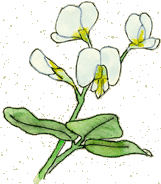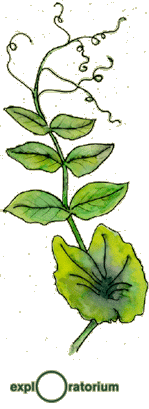|

|

|
|||||||||||||
|

|
 Hybrids
Hybrids
You, your family, and your neighbors all belong to the species Homo sapiens, but each of you differ slightly from each other genetically. Some of these differences are visible—for example, height and skin color. Other differences, such as metabolism and hormone levels, are more subtle. Members of any given plant species vary in similar ways—some are taller, some are more drought-resistant, and so on. |
||||

|
In nature, the highest priority of a plant is to reproduce itself. In the garden, the highest priority for that plant will be determined by the gardener’s intentions, which she’ll fulfill by taking advantage of how the plant reproduces itself. If she wants taller stalks, for instance, she’ll force the plant to breed with another of its kind that’s tall. The likely result will be offspring—known as hybrids—with taller stalks than the original plant. For millennia, farmers and gardeners without any knowledge of genetics have used this forced breeding to bring out plant traits that are useful for humans. They then save the seeds from the plants they like best, in effect passing along those qualities to future generations. The people performing these unnatural plant crosses 10,000 years ago were the original genetic manipulators. Their plant hybridization was the earliest practice of agriculture. In the 12,000 years that followed, plant breeders became extraordinarily adept at creating hybrids, and their manipulations led to nearly all of the food we see on our tables today. In 1859, an observant Charles Darwin noted a simple but profound fact: Breeders could direct change in a plant or animal species over generations by choosing which individual it mated with. He called this process “artificial selection,” and his thoughts about it led him to his ideas of natural selection (and thus to evolution). In fact, the first chapter of The Origin of Species is a record of these observations. At the time Darwin was writing Origins , an Austrian monk named Gregor Mendel was experimenting with pea plants. He cross-pollinated plants with different colored flowers and differently shaped peas to see what the resulting offspring would look like. Pairings like this happen naturally in the wild, in a more random way. By precisely controlling it and keeping careful records, Mendel took hybridization a step further. When his work finally came to light in 1900, plant breeders everywhere could cross-pollinate with more accuracy. Their efforts have brought us such plant varieties, or cultivars, as sweetheart and bridal white roses, beefsteak and roma tomatoes. As our knowledge of genetics increased during the last century, so did the sophistication of hybrid plant breeding. Breeders now follow complex schemes that involve cross-pollinating two plants that have been inbred for several generations. This results in offspring that have been enhanced for better seedling survival, larger, stronger plants, or higher yields. This quality is known as “hybrid vigor.”
|
||||
|
|
|
|
|||
|
|
|
|
| © Exploratorium |